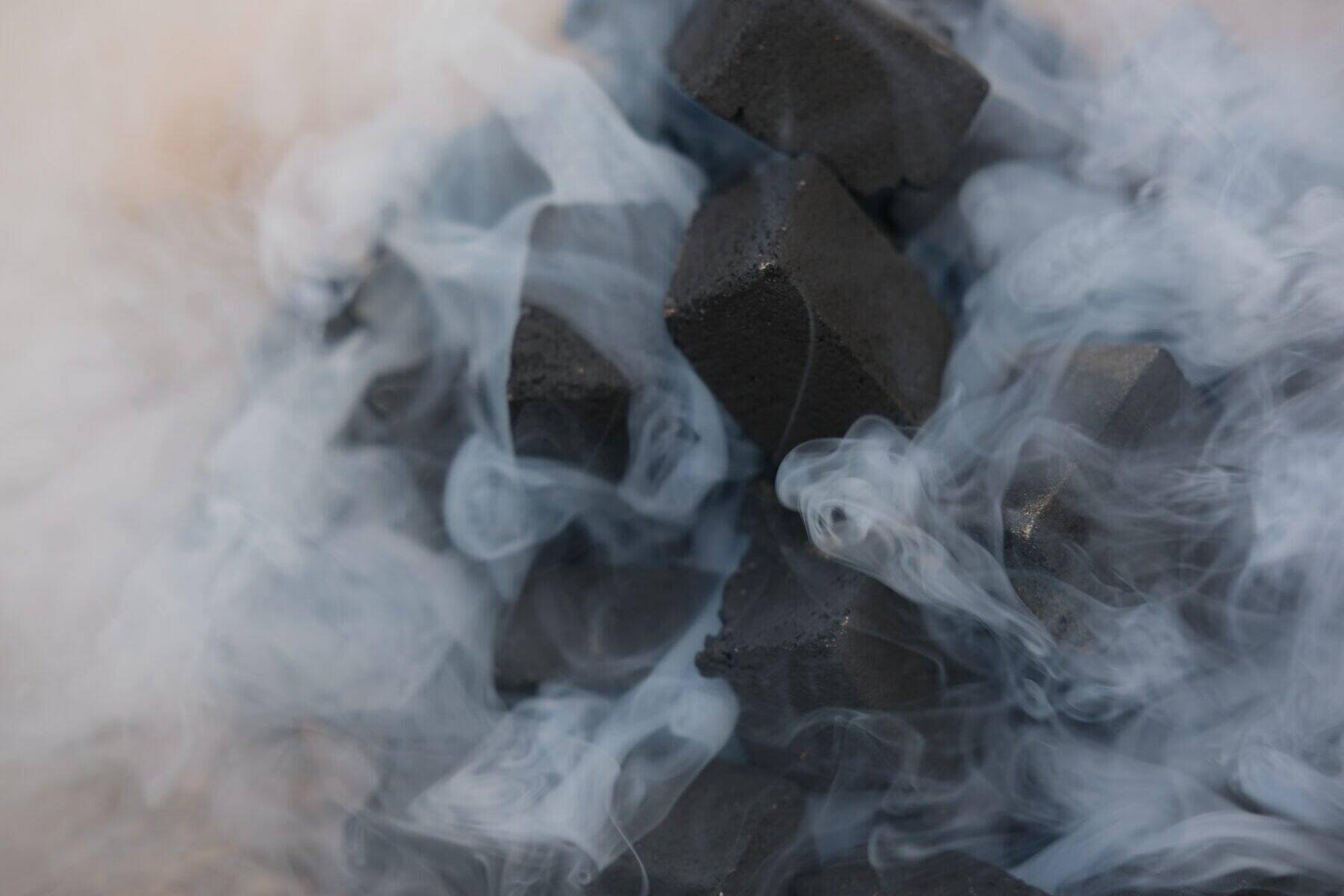What Is Activated Charcoal? (How It's Made)

Activated charcoal is a fine black powder made from charred bones, coal, petroleum coke, and coconut shells.
It is treated with oxygen at high temperatures to make it more porous and increase its surface area.
The production process of activated charcoal involves heating carbon-rich materials at high temperatures using various activation methods, resulting in a highly porous product with impressive adsorption capabilities. (3)
Its powerful adsorption capabilities make activated charcoal a popular choice for various applications ranging from food additives and toothpaste to supplements for digestive health. (4)
Different types of activated charcoal include powdered, granulated, and capsule forms.
Each has unique benefits, such as absorbing chemicals and toxins from your system and easing gas and bloating.
Many people turn to activated charcoal capsules when they experience occasional gas or bloating issues because the highly porous nature of this substance helps bind unwanted substances in the stomach before they can be absorbed into the body.
Differences between activated charcoal and regular charcoal
While both activated charcoal and regular charcoal are derived from carbon, they differ significantly in their properties, production process, and uses. (2)
Regular charcoal, commonly used for cooking or heating purposes, is a residue left after burning organic material like wood or coconut shells at high temperatures in the presence of limited oxygen.
On the other hand, activated charcoal undergoes an additional activation process that dramatically increases its porosity and overall surface area.
This process involves exposing carbon-rich materials to high temperatures while treating them with oxygen or other chemicals such as steam or acid.
The result is a highly porous substance with numerous minuscule pores capable of trapping various contaminants through adsorption.
Production Process Of Activated Charcoal
The production process of activated charcoal involves heating carbon-rich materials like coconut shells or sawdust to high temperatures and subjecting them to different activation methods, resulting in a highly porous product with impressive adsorption capabilities. (1)

Raw materials and sources of production
Activated charcoal is created from an assortment of carbon-rich raw materials. Some familiar sources used in its production include charred bones, coconut shells, peat, sawdust, and even coal or petroleum coke.
This fine black powder starts with obtaining suitable raw materials from sustainable sources.
For instance, coconut shells have become popular due to their renewable nature and minimal environmental impact compared to other options such as coal or petroleum-based products.
Carbonization and activation methods
Carbon-rich materials like wood, coconut shells, or coal are burned at high temperatures to make activated charcoal.
Here are the two fundamental processes used to create activated charcoal:
- Physical Activation: In this process, the carbon source is heated in a low-oxygen environment and then exposed to air or steam. This helps create the pores needed for adsorption.
- Chemical Activation: The second process involves treating the carbon source with an activating agent like phosphoric acid, zinc chloride, or potassium hydroxide. This helps open up the pores on a molecular level.
No matter which method is used, the key to producing high-quality activated charcoal is in controlling how long and at what temperature it is exposed to heat and/or chemicals during production.
Activated charcoal made through physical activation has larger pores, giving it more surface area for adsorbing gases and liquids.
Chemically-activated charcoal has smaller pores that can filter out finer particles and impurities.
When choosing an activated charcoal supplement, consider if you need a product with larger or smaller pores depending on your specific needs.
Different types of activation methods
Activated charcoal can be made using different methods. These are some of the ways activated charcoal can be created:
- Physical Activation: This method involves heating the raw materials in a controlled environment without chemical additives. The heat causes the material to break down and form pores, which activate the carbon.
- Chemical Activation: Chemical activation adds chemicals to the raw materials, such as phosphoric acid or potassium hydroxide, before heating. This method produces activated charcoal with large surface areas and high adsorption capabilities.
- High-Temperature Steam Activation: This method uses steam at high temperatures to create activated charcoal. The steam reacts with the carbon to create additional pores and surface area.
- Microwaving: Using microwaves to activate charcoal is a newer method that involves heating carbon-rich materials with microwaves, creating pores in the material.
Activated charcoal offers various benefits for medical and non-medical use, effectively absorbing toxins and purifying air and water.

Types & Use of Activated Charcoal
There are different types of activated charcoal, such as powdered, granulated, and capsules, each with unique benefits.
Powdered activated charcoal
Powdered activated charcoal is a fine black powder made from charred bones, coconut shells, or coal. It has high adsorption capabilities and is commonly used in food, toothpaste, and supplements.
In fact, it has been found to help with gas and bloating by binding to gases in the digestive tract.
Additionally, it can be mixed with water to create a paste that can be applied topically for various purposes, such as teeth whitening or treating insect bites.
Granulated activated charcoal
Granulated activated charcoal, or GAC, is a popular form of activated charcoal processed into tiny granules. It is very effective in removing impurities and contaminants from water and air due to its large surface area and porous structure.
GAC is commonly used in household drinking water filters because it removes chlorine, pesticides, lead, and other harmful contaminants from tap water.
It can also be found in fish tank filters or aquariums, which helps keep the environment clean for aquatic life.
Activated charcoal capsules
Capsules are a great option if you're looking for a convenient way to reap the benefits of activated charcoal.
Activated charcoal capsules contain the same fine black powder as other forms of activated charcoal, but they're easier to take and more portable.
They can be taken with water or added to smoothies for an easy dose.
Activated charcoal capsules offer all the benefits of other forms of activated carbon, such as absorbing chemicals and toxins from your system, easing gas and bloating, and promoting better skin health. (4)
They also have some specific advantages over powdered or granulated forms:
- They don't leave any residue in your mouth or teeth when you swallow them, making them ideal for on-the-go use.
- They're easy to measure out precisely.
- They allow you to control the dosage more accurately than other forms do.
Comparison of types of activated charcoal
In this section, we will compare the different types of activated charcoal to help you decide when to choose the best one for your needs.
| Type | Form | Usage | Benefits | Considerations |
|---|---|---|---|---|
| Powdered Activated Charcoal | Fine black powder | Toothpaste, food, drinks, face masks, and supplements | Highly absorbent, removes toxins and odors. Easy to mix with liquids. | It can be messy and may stain surfaces or clothing. |
| Granulated Activated Charcoal | Small granules | Water and air filtration systems | Effectively remove impurities, chemicals, and gases from water and air. | Less versatile for personal use; generally used in industrial applications. |
| Activated Charcoal Capsules | Capsules filled with activated charcoal powder | Supplements for digestive health and detoxification | Portable, easy to consume, and convenient for on-the-go use. Helps to ease gas and bloating. | Not suitable for toothpaste or topical application |
Each type has unique advantages and limitations, so selecting the one that best suits your requirements and preferences is essential.
Final Thoughts on Activated Charcoal
Activated charcoal comes in various forms, from powdered to granulated and even capsule forms, each tailored for specific benefits and applications.
Whether you're looking to detoxify, purify water, or enjoy clearer skin, there's an activated charcoal product for you.
Ready to experience the benefits for yourself?
Choose Wild Foods Co. Coconut Activated Charcoal for a natural, effective solution to eliminate toxins and impurities from your life.
Order now and enter a world of enhanced wellness!
Or explore further with our blog, activated charcoal vs bamboo charcoal.
FAQs
What is activated charcoal, and how is it made?
Activated charcoal is a form of carbon processed to increase its surface area and make it more porous. It is made by heating carbon-rich materials, such as wood, coconut shells, or peat, to very high temperatures. This process creates spaces or "pores" in the charcoal, which help trap chemicals.
What are the possible uses of activated charcoal?
Activated charcoal is used in medicine to treat certain types of poisoning or overdose. It is also used for gastrointestinal decontamination in emergencies. Some people take activated charcoal supplements to remedy intestinal gas and high cholesterol or to reduce diarrhea.
Is activated charcoal safe to take?
A: Orally administered activated charcoal is considered safe for most people when used in appropriate amounts. However, it may cause adverse effects such as constipation or black stools. It is important to follow dosing instructions and consult a healthcare professional before using activated charcoal as a supplement or for medicinal purposes.
How does activated charcoal work in the body?
A: Activated charcoal works by binding to toxins and chemicals in the gastrointestinal tract, preventing their absorption into the bloodstream. This absorption process helps trap unwanted substances, allowing the body to excrete them through bowel movements.
Can activated charcoal interact with herbs and supplements?
Activated charcoal may interfere with certain herbs and supplements absorption if taken simultaneously. To avoid potential interactions, it is recommended to space out the intake of activated charcoal and other medications or supplements by at least 2 hours.
When should activated charcoal be administered for poisoning?
Activated charcoal is most effective when administered within the first hour of poison ingestion. It helps reduce the absorption of toxic substances in the stomach and intestines, preventing them from entering the bloodstream and causing harm.
What are the side effects of using activated charcoal?
Common side effects of activated charcoal may include constipation, black stools, or vomiting. In rare cases, it may lead to gastrointestinal blockages or aspiration if improperly administered. It is essential to seek medical advice if any adverse reactions occur.
Related Studies
- The article "Activated Charcoal—Past, Present and Future" from the National Library of Medicine provides an overview of activated charcoal, its history, and current uses.
- The article "Activated charcoal: Uses, Interactions, Mechanism of Action" from DrugBank Online explains the differences between activated charcoal and regular charcoal, including their preparation, properties, and uses.
- The article "Activated Carbon, Biochar and Charcoal: Linkages and Synergies across Pyrogenic Carbon's ABCs" from MDPI provides a detailed overview of the production process and activation methods of activated charcoal, including physical and chemical activation methods.
- The article "What are the benefits of activated charcoal?" from Medical News Today discusses the potential health benefits of activated charcoal, including its use in detoxification, digestive health, and skin health.
